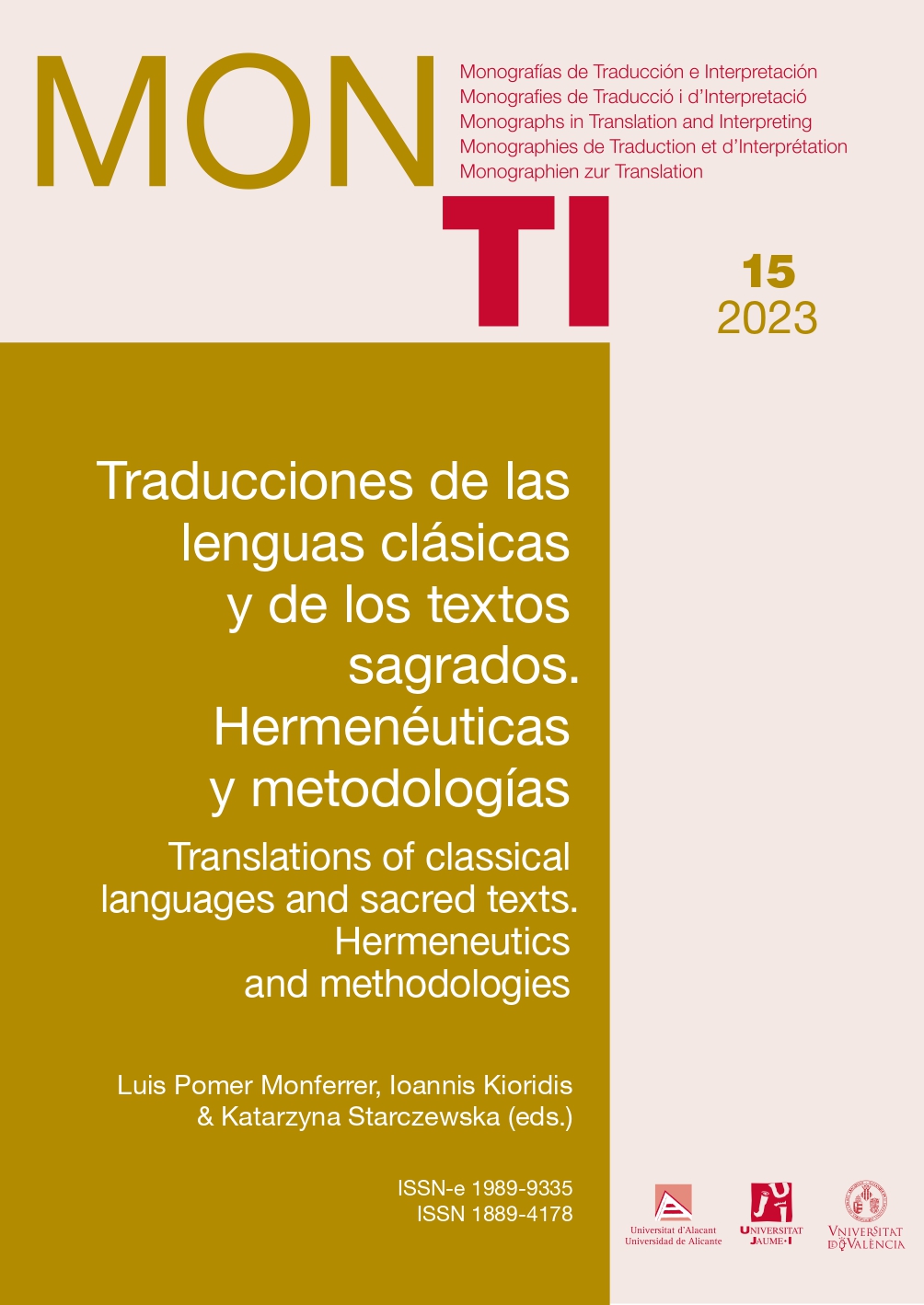Biblical translation: do different strategies produce divergent texts?
Main Article Content
Abstract
In our paper we intend to verify the effectiveness of the different “translation strategies” applied to the translation of the Christian Bible through a historical and textual analysis of various biblical versions into two vernacular languages of Western Europe (German and Spanish). Because of the anthropological particularity of the books that compose it (the postulate of its divine inspiration), the possible application of a translation strategy will depend on the position that the translator maintains regarding the sacred character of the text: if he/she considers it a sacred and untouchable text, if he/she admits the variation of the formal tenor of the text while the core message is saved, or if, in order to facilitate easy reading and understanding of the message, greater textual alterations are allowed. We will examine whether the translation strategy (implicit or explicit) has truly been decisive in producing mismatched translations, both in the meaning, and also in the literality and literariety (readability) of the texts.
Downloads
Article Details
The documents contained in these directories are included by the contributing authors as a means to ensure timely dissemination of scholarly and technical work on a non-commercial basis. It is understood that all persons copying this information will adhere to the terms and constraints invoked by each author's copyright. These works may not be reposted without the explicit permission of the copyright holder.
References
BARRERA, Trebolle. (1998) The Jewish Bible and the Christian Bible. Leiden: Brill Eerdman.
Biblia del Oso. (1569) BIBLIATODO. Versión electrónica: htpp://www.bibliatodo.com/La-biblia-del-oso-1569/Cantares-1
BIBLIOTECA DE AUTORES CRISTIANOS. (1993) Epistolario. 2ª ed. a cargo de J. Bautista Valero. Madrid: SJ.
CICERÓN, Marco Tulio. (46 a. C.) De optimo genere oratorum. Biblioteca Virtual Miguel de Cervantes. Versión electrónica: https://www.cervantesvirtual.com/portales/tovar/obras/materia/ciceron-marco-tulio-de-optimo-genere-oratorum-17196
DE ENZINAS, Francisco. (1543) Nuevo Testamento traducido por Francisco de Enzinas. Antwerpen: P. Mierdman. Versión electrónica: https://archive.org/details/NTDeEnzinas/page/n9/mode/2up
DE LEÓN, Fray Luis. (1559) Cantar de cantares de Salomón. Edición de Javier San José Leta. Biblioteca Virtual Miguel de Cervantes. Versión electrónica: https://www.cervantesvirtual.com/obra-visor/cantar-de-cantares-de-salomon--0/html/01e17fb4-82b2-11df-acc7-002185ce6064_2.html
DE REINA, Casiodoro. (1569) “Introducción [a la Biblia].” En: Sagradas Escrituras Versión Antigua. Transcrita y puesta en español actual por Russell Martin Stendal en su revisión de 1996. Texto extraído de la edición digital presentada por Equipo Biblioteca Hispana Internacional (2019): https://esword-espanol.blogspot.com/2018/08/stendal1996-sagradas-escrituras-version.html
FÜRST, Alfons. (2004) Hieronymus. Askese und Wissenschaft in der Spätantike. Basel: Herder.
HUMBOLDT, Wilhelm von. (1820/1822) “Über das vergleichende Sprachstudium in Beziehung auf die verschiedenen Epochen der Sprachentwicklung.” En: Abhandlungen der Königlichen Akademie der Wissenschaften zu Berlin aus den Jahren 1820-1821. Berlin: Brandenburgische Akademie der Wissenschaften, pp. 239-260.
KING JAMES BIBLE. Versión electrónica: https://www.kingjamesbibleonline.org/
LANCELLE, Rüdiger. (2002) Hoffnung fuer alle. Ulm: International Bible Society.
LUTERO, Martín. (1530/2002) Sendbrief vom Dolmetschen/Del arte de traducir. Edición y traducción de Tobias Brandenberger. Madrid: Caparrós editores.
Lutherbibel. (1545) New Christian Bible Study. Versión electrónica: https://newchristianbiblestudy.org/bible/german-luther-1545/song-of-solomon
REISS, Katherina. (1976) Texttyp und Ubersetzungsmethode. Kronberg: Scriptor-Verlag.
SCHLEIERMACHER, Friedrich. (1813) Über die verschiedenen Methoden des Übersetzens. Berlin: De Gruyter Mouton.
SAN JERÓNIMO. (1993) De optimo genere interpretandi. En: Epistolario I. Traducción, introducción y notas de Juan Bautista Valero. Madrid: BAC.
SAN JERÓNIMO. (2002) Obras completas. Comentario a Mateo y otros escritos. Madrid: BAC.
SIMMEL, Oskar & Rudolf Stählin. (1958) Die christliche Religion. Frankfurt: Fischer Verlag.
STENDAL, Russell Martin. (1996) Sagradas Escrituras. Versión Antigua. EBH Internacional. 2019. Versión electrónica:
https://esword-espanol.blogspot.com/2018/08/stendal1996-sagradas-escrituras-version.html
VARIOS AUTORES. (1980) Einheitsübersetzung der Heiligen Schrift. Stuttgart: Katholische Bibelanstalt GmbH. Versión electrónica: https://bibel.github.io/EUe/
VARIOS AUTORES. (2004) Die Bibel. Einheits Ubersetzung. Altes und Neues Testament. Freiburg im Breisgau: Herder.
VEGA, Miguel Ángel. (1994) Textos clásicos de teoría de la traducción. Madrid: Cátedra.
VINAY, Jean Paul & Jean Darbelnet. (1958) Stilistique comparée de français et de l’anglais. Paris: Didier.
ZUBER, Roger. (1968) Les belles infideles et la formation du goût classique: Perrot d’Ablancourt et Guez de Balzac. Paris: Editorial Champion.


